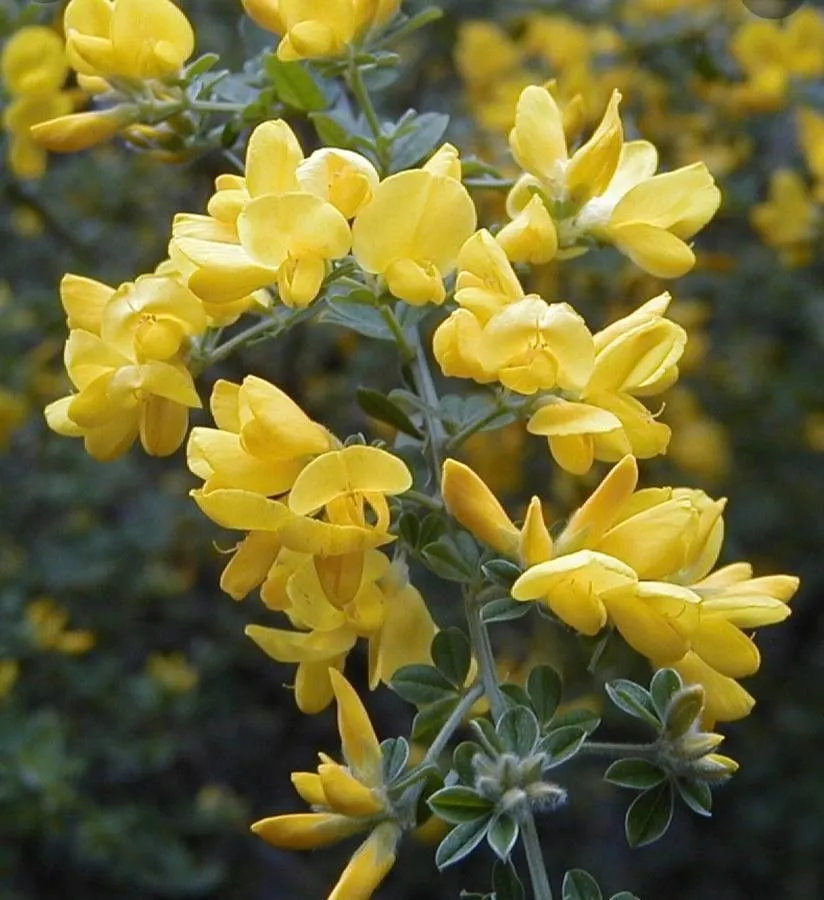
Author: L.
Bibliography: Sp. Pl.: 710 (1753)
Year: 1753
Status: accepted
Rank: species
Genus: Genista
Vegetable: Unknown
Observations: Europe
Hairy greenweed, known scientifically as Genista pilosa, is an intriguing plant species that falls under the Fabaceae family. This resilient plant is predominantly found across various regions of Europe, where it thrives in its natural habitat.
Characterized by its hairy stems and leaves, Genista pilosa possesses a distinctly robust and bushy appearance. The plant typically reaches modest heights, forming dense, low-lying mats that can efficiently cover ground, making it a valuable species for soil stabilization and erosion control. Its branches are thin and woody, clad in tiny, fine hairs that contribute to the plant’s name and give it a soft, almost velvety texture.
The foliage of the hairy greenweed consists of small, narrow leaves that are also covered in fine hairs. These leaves are arranged alternately on the stems and exhibit a rich green hue that adds to the plant’s aesthetic appeal. During its blooming season, Hairy greenweed produces bright yellow flowers that form attractive clusters. These vibrant blossoms not only enhance the visual appeal of the plant but also play a critical role in supporting various pollinators, thereby contributing to local biodiversity.
One of the essential aspects of the Genista pilosa’s significance is its adaptability to different environmental conditions, particularly in Europe. It typically grows in well-drained soils, preferring sunny locations where it can flourish with minimal care. This resilience makes it an excellent candidate for natural landscaping and restoration projects.
In historical botanical literature, Genista pilosa was first described by the renowned scientist Carl Linnaeus in 1753, with the formal citation appearing in his seminal work, “Species Plantarum.” Linnaeus, often referred to by the abbreviated author name “L.”, played a pivotal role in the classification and understanding of this species, further cementing its place in botanical history.
Overall, the hairy greenweed stands out not only for its ecological importance and adaptability but also for its striking visual characteristics and historical botanical significance.
Deu: behaarter ginster
Dan: håret visse
Fra: genêt velu
Cat: ginestola pilosa
Eng: hairy greenweed
Swe: hårginst
Nld: kruipbrem
Nno: hårginst
Nob: hårginst
Cym: aurfanadl blewog, corfanhadlen flewog
En: Hairy greenweed, Gold flash broom, Gold-flash broom, Silky-leaf woodwaxen, Silkyleaf woodwaxen
Ca: Ginestola pilosa
Cs: Kručinka chlupatá
Da: Håret Visse
Nl: Kruipbrem, Zachte Brem
Fi: Karvaväriherne
Fr: Genêt velu, Genêt poilu, Genette, Genêt pileux
De: Behaarter Ginster, Haar-Ginster, Haarginster, Heide-Ginster, Sandginster
Hu: Selymes rekettye
It: Ginestra tubercolosa, Ginestra pelosa, Ginestra tuberculosa, Martinello
Nb: Hårginst
Nn: Hårginst
Pl: Janowiec włosisty
Sk: Kručinka chlpatá
Sv: Hårginst
Cy: Corfanhadlen flewog, Aurfanadl Blewog
Taken Oct 20, 2020 by martin (cc-by-sa)
Taken May 26, 2021 by Olivier Brosseau (cc-by-sa)
Taken May 26, 2018 by Llandrich anna (cc-by-sa)
Taken Jul 20, 2021 by Alain Bigou (cc-by-sa)
Taken Jun 14, 2021 by Alain Bigou (cc-by-sa)
Taken Jun 17, 2019 by Jeanine Vialatte (cc-by-sa)
Taken Apr 9, 2021 by Albert Mallol Camprubí (cc-by-sa)
Taken Jun 14, 2021 by Alain Bigou (cc-by-sa)
Taken Jun 14, 2021 by Alain Bigou (cc-by-sa)
Taken May 7, 2020 by lopezlacasa (cc-by-sa)
© copyright of the Board of Trustees of the Royal Botanic Gardens, Kew.
© copyright of the Board of Trustees of the Royal Botanic Gardens, Kew.
© copyright of the Board of Trustees of the Royal Botanic Gardens, Kew.
Taken May 26, 2021 by Olivier Brosseau (cc-by-sa)
Taken Mar 26, 2017 by Yoan MARTIN (cc-by-sa)
Taken May 3, 2021 by Alain Bigou (cc-by-sa)
Taken Jul 20, 2021 by Alain Bigou (cc-by-sa)
Taken Jun 14, 2021 by Alain Bigou (cc-by-sa)
Taken May 29, 2022 by Acosta García Isabel (cc-by-sa)
Taken Sep 6, 2014 by Tela Botanica − Liliane Roubaudi (cc-by-sa)
Taken Jul 8, 2011 by Tela Botanica − Mathieu MENAND (cc-by-sa)
Taken Jul 11, 2013 by Tela Botanica − Liliane Roubaudi (cc-by-sa)
Taken Jul 20, 2021 by Alain Bigou (cc-by-sa)
Taken Jun 23, 2019 by Renaud Brochiero (cc-by-sa)
Taken Apr 12, 2014 by Tela Botanica − Geneviève Botti (cc-by-sa)
Taken May 3, 2021 by Alain Bigou (cc-by-sa)
Taken Jul 20, 2021 by Alain Bigou (cc-by-sa)
Taken May 3, 2021 by Alain Bigou (cc-by-sa)
Taken Apr 9, 2022 by rohner christina (cc-by-sa)
Taken Apr 16, 2021 by andréa va (cc-by-sa)
Taken Mar 26, 2017 by Yoan MARTIN (cc-by-sa)
Taken May 30, 2021 by Easger Aukema (cc-by-sa)
Taken May 26, 2018 by Llandrich anna (cc-by-sa)
Family: Myrtaceae Author: (F.Muell.) K.D.Hill & L.A.S.Johnson Bibliography: Telopea 6: 402 (1995) Year: 1995 Status:…
Family: Rubiaceae Author: Pierre ex A.Froehner Bibliography: Notizbl. Bot. Gart. Berlin-Dahlem 1: 237 (1897) Year:…
Family: Sapindaceae Author: Koidz. Bibliography: J. Coll. Sci. Imp. Univ. Tokyo 32(1): 38 (1911) Year:…
Family: Asteraceae Author: A.Gray Bibliography: Pacif. Railr. Rep.: 107 (1857) Year: 1857 Status: accepted Rank:…
Family: Fabaceae Author: Medik. Bibliography: Vorles. Churpfälz. Phys.-Ökon. Ges. 2: 398 (1787) Year: 1787 Status:…
Family: Aspleniaceae Author: (Cav.) Alston Bibliography: Bull. Misc. Inform. Kew 1932: 309 (1932) Year: 1932…